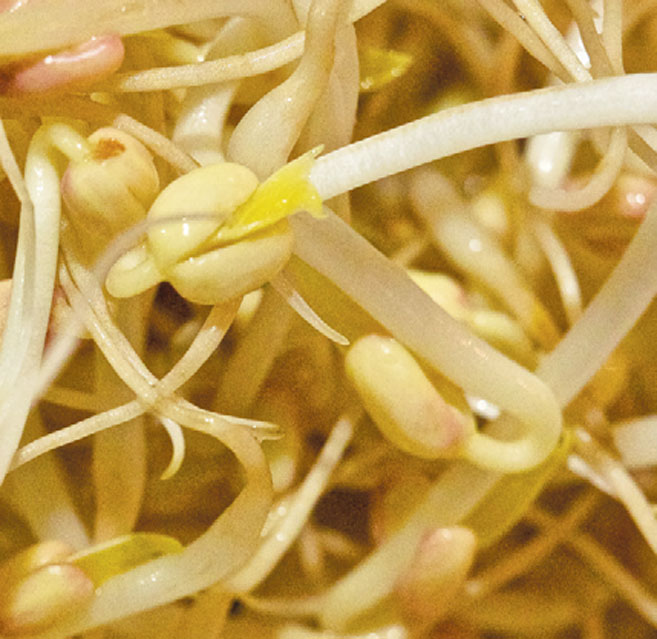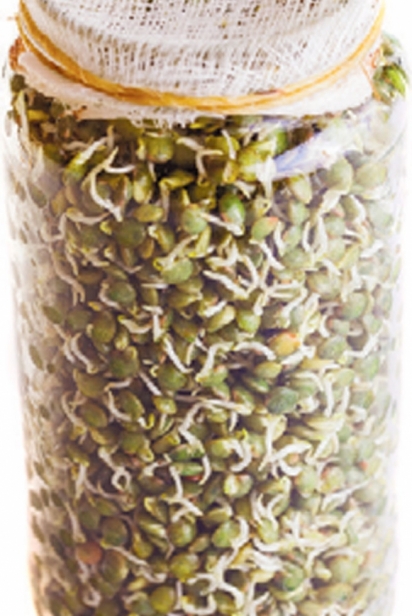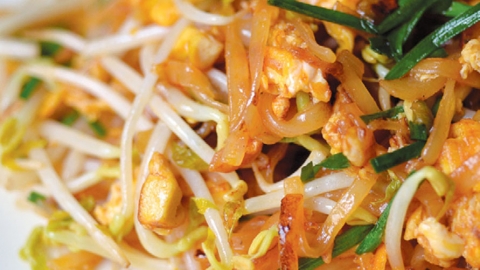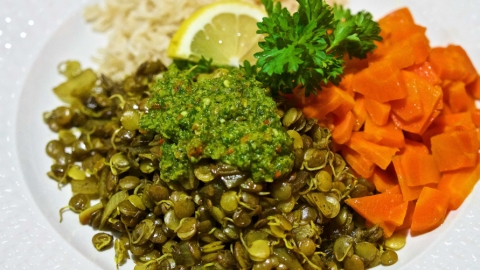Miraculous Sprouts
SUPER HEALTHY AND SUPER LOCAL
“Wanted! A vegetable that will grow in any climate, will rival meat in nutritive value, will mature in 3 to 5 days, may be planted any day of the year, will require neither soil nor sunshine, will rival tomatoes in Vitamin C, will be free of waste in preparation and can be cooked with little fuel..
— Dr. Clive McKay, professor of nutrition, Cornell University, 1940s
This miraculous food is known as “sprouts,” seeds that are germinated and then eaten raw or cooked. Dr. McKay fails to mention that the predecessor of this vegetable—the seed—is cheap, easy to find and can be stored for years with little loss of viability. Seeds in their dormant state are wrapped in a protective package with powerful natural chemicals that keep them stable for years. Judean date palm seeds have sprouted after waiting 2,000 years! (That venerable date palm is named Methuselah and is now 12 years old.)
The complex molecules that maintain seeds’ viability are hard to digest. They’re even called anti-nutrients (see sidebar below). But, when you add water, everything changes. Soaking the seeds starts the breakup of the defense mechanisms and the activation and assembly of nutrients for the emergent plant. As the seed germinates complex bio-chemical changes break down large molecules into simple, more digestible components. The anti-nutrients are disarmed and the changes are beneficial for human nutrition.
The Kitchen Counter Garden
You can grow sprouts easily on your kitchen counter with simple equipment and a little attention. Just 2½ ounces of mung beans will yield ½ pound of sprouts. At $3 a pound for organic mung beans, you’ll be harvesting sprouts for $1 a pound. Specialty “sprouting seed” can cost much more, but I’ve found organic beans and grains from the bulk bins work just fine for sprouting.
There are five major classes of seeds that can be sprouted: beans, grains, nut seeds, oil seeds and greens. Each takes a little different treatment and has a different use.
I tried out the simplest sprouts: wheat, lentils and mung beans. I have always wanted to make dense, sweet sproutedwheat Essene Bread. I have a good sprouted-lentil recipe. And, if things go well, I can use the mung beans in my favorite Pad Thai recipe.
Basic Instructions
I’m going to give you the basics. See “For More Information” for more detailed instructions.
Sprouts grow best at cool room temperature, 65°, with good air circulation. At warmer temperatures they need to be rinsed more frequently to stay fresh and to avoid mold and spoilage. The wheat and lentils are sprouted in a 1- or 2-quart glass jar, which should be spotlessly clean. Jars should be covered with a nylon net secured with a rubber band or canning lid ring. Retired panty hose work great or buy nylon netting from a fabric store. (Specialty lids are also available.)
Long-stem sprouts, like mung or soybeans, grow best in a colander or new red clay pot like you’d find at a nursery. They get a little different treatment.
1. Soak
I started with 3 cups of dry, hard winter wheat berries, 2 cups of lentils and 2 cups of mung beans to grow three different sprouts. Using a colander I rinsed the seeds and picked out the broken ones. Then I put each type of seed in a separate bowl and covered them with water 2—3 times over. I let them soak overnight, about 8—12 hours.
2. Rinse and Drain
In the morning I drained them, poured the wheat into a clean 2-quart jar and the lentils into two clean 1-quart jars and covered them with nylon nets, secured with the jar rings.
The mung beans went into a stainless steel colander lined with a paper. I put the colander in a bowl high enough so that the beans would be above any water that dripped off them. The seeds and stems can’t be sitting in water. I covered the colander with a kitchen towel.
After 8 hours I rinsed the seeds with a generous dose of cold water. I drained the jars and put them in my dish drainer, so every drop of extra water would run out. I drenched the mung bean sprouts in the colander, allowing the surplus water to drain into the sink, trying not to disturb the seeds. After that I rinsed the sprouts every 4—8 hours. For the record, I never got up at night to rinse them but I do I know that some people take them to work!
3. Harvest and Refrigerate
After one day I started seeing budding spots on the wheat.
On the second day the lentils and mung beans sent out tentative little feelers. Exciting changes. Each day I tasted the sprouts.
By day 2 the wheat sprouts had budding rootlets and a sprout that was about half as long as the grain. They tasted sweet. It was time to harvest and time to make Essene Sprouted Wheat Bread (see “Cooking Fresh” page 13.) Wheat sprouts continue to grow in the refrigerator, so they have to be used right away.
By the end of the third day, the lentils had sprouts that were about twice as long as the seed—that is, if you straightened them out, because they were curled. They were ready for harvest, so I patted them dry and put them in a plastic container in the refrigerator, where they will keep well for a few days.
I let the mung beans grow until the sixth day, when they started showing leaves. On the last day, I rinsed them every 4 hours, so the stems would be crisp and juicy. By harvest time they were densely packed, with 2-inch stems, seed heads and little emergent leaves. They looked just like sprouts at the Chinese market. So exciting. I patted them dry and lightly packed them into a quart Ziploc bag. They keep up to a week refrigerated.
Sprouts and Food Safety
The Chinese have been eating sprouts for 5,000 years but now the US Food and Drug Administration considers them hazardous. The FDA recommends buying inspected seed, soaking the seeds and everything else in a bleach solution and, even then, not serving raw sprouts to children, oldsters or other susceptible groups. Yikes!
Scary, but how have the Chinese done it for all those thousands of years? Cooking. The Chinese never eat raw sprouts, and they never eat raw vegetables. The FDA cautions are for raw sprouts. Cooking for just 1 minute at 160° kills any pathogens with very little loss of some nutrients and an actual gain in others. So to enjoy safe sprouts without worry, cook the sprouts as in the delicious recipes below.
Get Sprouting
If you don’t have room or water for a garden, if it’s too cold or too hot outside, if you don’t want to wait months pulling weeds and watching for insect pests, you can still harvest fresh, delicious, nutrient-dense foods right on your kitchen counter. It doesn’t get more local than that.
Sprout Cautions
Growing Seed Sprouts at Home, publication 8151 from the University of California at Davis, lists these cautions:
Since 1995, raw sprouts have emerged as a significant source of food-borne illness in the United States. These illnesses have involved the pathogenic bacteria Salmonella and E. coli 0157:H7. Alfalfa, clover and mung bean sprouts have been involved most frequently, but all raw sprouts may pose a risk.
For most outbreaks, the source of contamination appears to have been the seed. Even if the seed is contaminated, pathogen levels are typically very low, so contamination can easily be missed depending on the nature of the seed-testing program. The best conditions for sprouting are also ideal for multiplication of pathogenic bacteria if they happen to be present on the seed. Even if the seed are only lightly contaminated. Salmonella and E. coli 0157:H7 levels can increase to millions of cells per serving during the sprouting process.
Because illnesses from these organisms can range from mild to extremely unpleasant and even to very severe in susceptible persons^ the U.S. Food and Drug Administration and the California Department of Health Services have issued warnings to consumers.
For More Information
I looked at sproutpeople.org and found a ton of information. They have detailed instructions for each type of sprout along with nutritional information, scientific reports and recipes. They also sell equipment and specialty seeds. It's a great site.
Terroir Seeds
an Arizona source for seeds and sprouting equipment
underwoodgardens.com/how-to-grow-sprouts-at-home/
International Sprout Growers Association
History, recipes, nutrition
isga-sprouts.org
Maangchi
Mung and soy bean sprout recipes and video
maangchi.com
Sprout Nutrients
You could read a sheaf of research on sprouts but I'll just enjoy them for dinner. These are some of the seeds' anti-nutrients disarmed by sprouting:
• Phytic acid binds minerals within the seeds and reduces bioavailability of iron, zinc, magnesium and calcium.
• Raffinose is a complex carbohydrate occurring in beans. It's indigestible for many people and causes the undesirable consequence of intestinal gas and bloating.
• Protease inhibitors interfere with protein digestion by inhibiting digestive enzymes.
• Lectins are proteins that interfere with the absorption of nutrients and can cause digestive upsets.
Sprouting changes seeds. In general:
• Protein quantity and availability increases 50%.
• Complex starches are broken down into digestible sugars.
• Antioxidants like vitamin C, B complex, vitamins A and E increase up to 20 times.
• Minerals become more bio-available.
• Phytochemical content soars, including plant estrogens, saponins, bio-flavinoids, quercetin, isoflaves, sulphurophanes, phytoesterols and flavonetricin.










